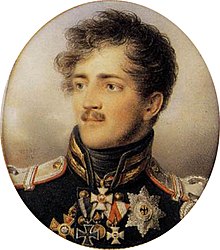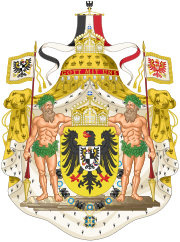Prince Augustus of Prussia
| Prince Augustus of Prussia | |||||
|---|---|---|---|---|---|
 Portrait by Jean-Baptiste Isabey, 1814 | |||||
| Born | 19 September 1779 Friedrichsfelde, Kingdom of Prussia | ||||
| Died | 19 July 1843 (aged 63) Bromberg, Kingdom of Prussia | ||||
| Burial | |||||
| |||||
| House | Hohenzollern | ||||
| Father | Prince August Ferdinand of Prussia | ||||
| Mother | Margravine Elisabeth Louise of Brandenburg-Schwedt | ||||
| Prussian Royalty |
| House of Hohenzollern |
|---|
 |
| Descendants of Frederick William I |
|
Prince Frederick William Henry Augustus of Prussia (German: Friedrich Wilhelm Heinrich August; 19 September 1779 – 19 July 1843) was a Prussian royal and general. Born on Friedrichsfelde Palace, he was the youngest son of Prince Augustus Ferdinand of Prussia, the brother of King Frederick the Great, and Margravine Elisabeth Louise of Brandenburg-Schwedt.
Military career[edit]
August joined the Prussian army as a young man, earning the rank of captain by eighteen years old. In 1803, he became a major and was granted an infantry battalion of his own. Three years later, now a lieutenant colonel, he and his battalion took part in the Battle of Auerstedt. His brother, Prince Louis Ferdinand, had been killed by the French army under Napoleon I four days earlier. August himself was captured and held by the French until 1807.
In March 1808, his cousin, King Frederick William III of Prussia, made him brigadier general. The Prince spent the next five years reorganizing the Prussian artillery together with Gerhard von Scharnhorst. Seven years after the failure of the Prussian army at Auerstedt, the Prince distinguished himself at the Battle of Leipzig. He continued his campaign against Napoleon throughout 1814. In the winter 1814-1815, August attended the Congress of Vienna. He moved to the north of France in June 1818 and then back to Berlin after the war had ended.
He spent his last years inspecting artillery units in various garrison towns. He died suddenly in Bromberg during one such trip, and was buried in Berlin Cathedral in a service accompanied by the Staats- und Dom Choir Berlin.
Relationships and estate[edit]
Although he was one of the richest landowners in Prussia, his estates reverted to the Crown upon his death, since he never left any legitimate heirs. His first mistress, Karoline Friederike Wichmann, with whom he cohabited from 1805 until 1817, bore him four children. She was ennobled as Baroness von Waldenburg. His second mistress was Auguste Arend, later ennobled as Baroness von Prillwitz. They were together from 1818 until her death in 1834, and had seven children. Shortly after Baroness Von Prillwitz's death he began a relationship with and morganatically married Emilie von Ostrowska, a Polish noblewoman. They had a daughter, Charlotte, who was five when her father died, and was raised by her father's Jewish tailor.[1]
Honours[edit]
He received the following orders and decorations:[2]
 Kingdom of Prussia:
Kingdom of Prussia:
- Knight of the Black Eagle, 19 August 1786[3]
- Iron Cross (1813), 2nd Class
- Service Award Cross
 Austrian Empire:
Austrian Empire:
- Knight of the Military Order of Maria Theresa, 1813[4]
- Grand Cross of St. Stephen, 1837[5]
 Brunswick: Grand Cross of Henry the Lion
Brunswick: Grand Cross of Henry the Lion Kingdom of Hanover:[6]
Kingdom of Hanover:[6]
- Grand Cross of the Royal Guelphic Order, 1839
- Knight of St. George, 1839
 Hohenzollern: Cross of Honour of the Princely House Order of Hohenzollern, 1st Class
Hohenzollern: Cross of Honour of the Princely House Order of Hohenzollern, 1st Class Kingdom of Sardinia: Knight of the Annunciation, 30 October 1832[7]
Kingdom of Sardinia: Knight of the Annunciation, 30 October 1832[7] Russian Empire:
Russian Empire:
- Knight of St. Andrew, 20 January 1809[8]
- Knight of St. Alexander Nevsky, 20 January 1809[8]
- Knight of St. Anna, 1st Class, 20 January 1809
- Knight of St. Vladimir, 2nd Class, 7 October 1813[8]
- Knight of St. George, 2nd Class, 10 January 1817[9]
 Two Sicilies: Knight of St. Januarius, 1834[10]
Two Sicilies: Knight of St. Januarius, 1834[10]
Ancestry[edit]
References[edit]
- ^ Haas, Eve (2013). The Secrets of the Notebook. Arcade Publishing. p. 273.
- ^ Preußen (1843). Handbuch über den Königlich Preußischen Hof und Staat: für das Jahr .... 1843. Decker. p. 6.
- ^ Liste der Ritter des Königlich Preußischen Hohen Ordens vom Schwarzen Adler (1851), "Von Seiner Majestät dem Könige Friedrich Wilhelm II. ernannte Ritter" p. 11
- ^ "Ritter-Orden: Militärischer Maria-Theresien-Orden", Hof- und Staatshandbuch des Kaiserthumes Österreich (in German), 1814, p. 18, retrieved 6 November 2019
- ^ "A Szent István Rend tagjai" Archived 22 December 2010 at the Wayback Machine
- ^ Hof- und Staats-Handbuch für das Königreich Hannover. Berenberg. 1842. pp. 33, 55.
- ^ Luigi Cibrario (1869). Notizia storica del nobilissimo ordine supremo della santissima Annunziata. Sunto degli statuti, catalogo dei cavalieri. Eredi Botta. p. 105.
- ^ a b c Almanach de la cour: pour l'année ... 1817. l'Académie Imp. des Sciences. 1817. pp. 63, 77, 156.
- ^ V. M. Shabanov (2004). Military Order of the Holy Great Martyr and Victorious George: A Nominal List, 1769-1920. Moscow. p. 928. ISBN 5-89577-059-2.
{{cite book}}: CS1 maint: location missing publisher (link) - ^ Angelo Scordo, Vicende e personaggi dell'Insigne e reale Ordine di San Gennaro dalla sua fondazione alla fine del Regno delle Due Sicilie (PDF) (in Italian), p. 9, archived from the original (PDF) on 4 March 2016
- ^ Genealogie ascendante jusqu'au quatrieme degre inclusivement de tous les Rois et Princes de maisons souveraines de l'Europe actuellement vivans [Genealogy up to the fourth degree inclusive of all the Kings and Princes of sovereign houses of Europe currently living] (in French). Bourdeaux: Frederic Guillaume Birnstiel. 1768. p. 19.
- Prussian princes
- Coppet group
- Generals of Infantry (Prussia)
- Prussian commanders of the Napoleonic Wars
- 1779 births
- 1843 deaths
- Recipients of the Iron Cross (1813)
- Knights Cross of the Military Order of Maria Theresa
- Grand Crosses of the Order of Saint Stephen of Hungary
- Recipients of the Order of St. George of the Second Degree
- Recipients of the Order of St. Anna, 1st class
- Recipients of the Order of St. Vladimir, 2nd class
- Burials at Berlin Cathedral
- Military personnel from Berlin
- People from Lichtenberg
